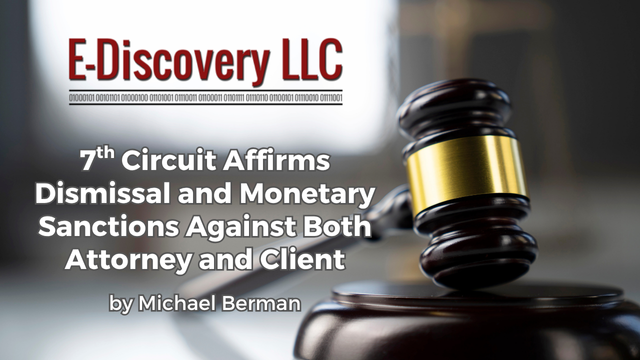
[EDRM Editor’s Note: The opinions and positions are those of Michael Berman.]
In this alleged wrongful termination and retaliation case, a “whistleblower” complaint was dismissed and monetary sanctions were also imposed. Pable v. Chicago Transit Authority, __ F. 4th __, 2025 WL 2102202 (7th Cir. Jul. 28, 2025).
The appellate court affirmed sanctions against both an attorney and client under three provisions: Fed.R.Civ.P. 37(e)(1 & 2); 28 U.S.C. §1927; and, Fed.R.Civ.P. 37(e)(5).
The monetary sanction was $75,175.42 under Rule 37(e)(1); plus $21,367 under Rule 37(a)(5); and, an additional $53,388 under 29 U.S.C. §1927. However, the Seventh Circuit denied sanctions under Fed.R.App.P. 38. The Rule 37(e)(1) sanction was divided equally between the attorney and client. The others were imposed on the attorney.
While there are many interesting and important points in this decision, I found two particularly noteworthy. For essentially the same conduct, the court imposed a Rule 37(e)(2) dismissal and also a Rule 37(e)(1) monetary sanction. It also held that, while Rule 37(e)(1) does not expressly provide for monetary sanctions, those sanctions are available under that provision.
For essentially the same conduct, the court imposed a Rule 37(e)(2) dismissal and also a Rule 37(e)(1) monetary sanction. It also held that, while Rule 37(e)(1) does not expressly provide for monetary sanctions, those sanctions are available under that provision.
Michael Berman.
TEXT OF THE SANCTIONS PROVISIONS
Under the curative sanction rule, Fed.R.Civ.P. 37(e)(1), if ESI that should have been preserved is lost due to the preserving party’s failure to take reasonable steps to preserve it, and if there is no satisfactory secondary evidence to replace it, the court “upon finding prejudice to another party from loss of the information, may order measures no greater than necessary to cure the prejudice….”
Game ending sanctions are available under Rule 37(e)(2) if the same predicate is met, but “only upon finding that the party acted with the intent to deprive another party of the information’s use in the litigation….”
Under 28 U.S.C. §1927: “Any attorney or other person admitted to conduct cases in any court of the United States or any Territory thereof who so multiplies the proceedings in any case unreasonably and vexatiously may be required by the court to satisfy personally the excess costs, expenses, and attorneys’ fees reasonably incurred because of such conduct.”
The motion to compel rule, Fed.R.Civ.P. 37(a)(5), provides that, if a motion to compel is granted, the court “must” require the opposing party or attorney to pay the movant’s reasonable expenses, including attorney’s fees, with three enumerated exceptions. One exception is where opposition is substantially justified.
As to appeals, Fed.R.App.P. 38 states: “If a court of appeals determines that an appeal is frivolous, it may, after a separately filed motion or notice from the court and reasonable opportunity to respond, award just damages and single or double costs to the appellee.”
WHAT HAPPENED?
It is complicated, and I am going to oversimplify. Pable and Haynes worked for the Chicago Transit Authority (“CTA”). Plaintiff Pable reported a software vulnerability to his supervisor, Haynes. Haynes ran a “test,” posting a “service alert” “on another city’s transit system.” The “test” allegedly created problems. Clever Devices, a CTA contractor, sent a claim letter to CTA. Pable and Haynes were terminated. Pable sued his employer, CTA, and Clever Devices.1
Timeline
Aug. 17-19, 2018:
Pable discovered a security vulnerability in the system used by CTA
that, in part, permitted posting of public alerts to the system.
Pable reported it to Haynes and configured a test.
Haynes used the test to post an alert on another city’s system.
Aug. 20, 2018:
Haynes disclosed the test to
the regional transit authority and his employer.
Oct. 22, 2018:
Clever Devices wrote to CTA alleging claims due to the “test.”
A decision was made to terminate Pable and Haynes.
Pable and Haynes were put on leave.
“At some point,” they were told they would be interviewed.
Oct. 29, 2018:
Pable contacted two attorneys.
Oct. 30, 2018:
Pable sent a follow up email to one attorney:
“I think they are trying to find any reason to terminate me
so I cannot take my FMLA and prevent payment of benefits.”2
Nov. 2, 2018:
Pable and Haynes met to discuss the upcoming interviews.
Haynes decided to delete his entire conversation thread with Pable on Signal.
Pable testified that his own messages disappeared when Haynes deleted thread.
CTA interviewed Pable and Haynes.
Pable stated that Haynes ran the test against Pable’s advice.
Pable and Haynes continued to communicate on Signal after this date.
Later:
Defendants learned that Pable and Haynes used Signal
to communicate about “what to do next” after the test.
Oct. 29, 2019:
Approximately a year later,
Pable activated the “disappearing messages” feature on his phone.
It caused messages to be deleted 24 hours after a recipient read them.
Jun. 12, 2020:
Pable’s attorney, Duffy, agreed to image Pable’s phone.
Oct. 24, 2020:
Pable’s attorney, Duffy, told the defense that he had imaged the phone,
and asserted that the 0.2 GB of user data “is a complete forensic image.”
Oct. 31, 2020:
Pable produced the first image of his phone.
A defense expert, Nathan Binder, determined that it lacked “key categories of information.”
Dan Jerger, a Quest Consultants International employee,
retained by Duffy, contradicted Duffy.
Jerger stated that Duffy limited the image by keywords and date range.
The image produced by Duffy was not a full forensic image.
Duffy stated that he
“believed that the image was complete in terms of producing relevant information.”
After a contested motion to compel, a second image of
Pable’s phone obtained by defendants’ vendor contained 25 GB.
In the court’s words, “the second imaging
revealed much more information than the first,”
but none of the post-Oct. 29, 2019, Signal messages.
Pable’s “Evolving” Explanations
The 7th Circuit said that Pable’s explanations for the deletion of the Signal messages on November 2nd “evolved over time.” First, Pable said that they vanished when Haynes deleted them. However, defendants filed an expert affidavit contradicting that assertion. Next, Pable filed an affidavit that he specially configured his Signal application to delete threads when other users deleted them. However, CTA responded “that Pable had not mentioned this explanation during his depositions.” It therefore challenged his credibility.
The Seventh Circuit wrote that the “Signal saga did not end there.” Pable and Haynes had continued to use Signal after November 2, 2018, but Pable had set the “disappearing messages” function on October 29, 2019. As noted above, those later messages could not be recovered in the 25 GB forensic image.
THE HOLDINGS IN PABLE
Sanctions Were Imposed and Affirmed
Defendants moved to dismiss the Complaint and for sanctions. In addition to alleging uncorrected misrepresentations, they asserted that “Pable failed to take reasonable steps to preserve three categories of Electronically Stored Information (ESI), including: (1) Signal messages exchanged with Haynes before November 2, 2018; (2) Signal messages exchanged after October 29, 2019; and (3) data on Pable’s personal cell phone.”
The district court agreed, dismissing the complaint with prejudice and imposing a series of monetary sanctions. The Seventh Circuit affirmed, but denied defendants’ requests for additional sanctions for the cost of the appeal.
The district court agreed, dismissing the complaint with prejudice and imposing a series of monetary sanctions. The Seventh Circuit affirmed, but denied defendants’ requests for additional sanctions for the cost of the appeal.
Michael Berman.
Dismissal Under Rule 37(e)(2)
The district court “ultimately found that Pable intentionally spoliated two categories of ESI and dismissal was appropriate to remedy the resulting prejudice.” This is a Rule 37(e)(2) analysis.
While the court said there was a plausible basis for Pable to assert that Haynes’ deletion of threads also caused a deletion from Pable’s phone, the district court was within its discretion to not credit it. The Seventh Circuit wrote:
After all, Pable’s explanation changed over time (first claiming that Haynes deleted the messages unilaterally, then adding that Pable had specifically configured the Signal application on his device to make a unilateral deletion possible). This evolution is notable because Pable made no mention of a custom configuration on his own phone when he offered his initial explanation, even though he would have known of that at the time and it would have been relevant to the deposition questions. Further, Pable offered no evidence other than his affidavit that such a configuration of Signal existed or was installed on his phone. Moreover, Pable’s explanation arrived only after he read the affidavit from the Signal COO refuting his prior explanation.
Pable v. Chicago Transit Authority, __ F. 4th __, 2025 WL 2102202 (7th Cir. Jul. 28, 2025).
The Seventh Circuit reviewed the finding of “intent to deprive.” It expressly adopted a “clear error” standard for Rule 37(e)(2)(C) appeals, and found no such error here. On these facts, no evidentiary hearing was required. Further, the Seventh Circuit held that there was no right to a jury trial on sanctions. And, the appellate court held that the district court had properly considered whether the severity was appropriate. Further, the appellate court agreed that Duffy’s conduct could be imputed to Pable and affirmed the Rule 37(e)(2) dismissal.
Monetary Sanction Under Rule 37(e)(1)
The court wrote: “As a curative measure under Rule 37(e)(1), the district court ordered Pable and Duffy to pay the reasonable attorney’s fees and costs incurred by the CTA in bringing its Rule 37(e) motion.” In my words, and in my opinion, it held that Rule 37(e)(1) permitted an award of attorney’s fees for a successful Rule 37(e)(2) motion.
The Seventh Circuit found no abuse of discretion on the issue of prejudice, a Rule 37(e)(1) requirement. And, the district court found that, in addition to the Rule 37(d)(2) dismissal, a monetary sanction was needed to cure that prejudice.
This, the district court reasoned, was necessary because the spoliation impacted not only the defendants’ ability to mount a defense but also caused them to incur fees and costs in litigating the spoliation itself. Specifically, the defendants spent $75,175.42 ($71,458.78 in attorney’s fees and $3,716.64 in costs) to take part of Pable’s second deposition, file several discovery motions and a subpoena, and brief the Rule 37 motion. Thus, dismissal alone would not have made them whole.
Id.
Neither Rule 37(e)(2) nor Rule 37(e)(1) expressly provide for monetary sanctions. The Seventh Circuit rejected Pable and Duffy’s appellate argument that the text of Rule 37(e)(1) does not authorize monetary sanctions. It wrote:
Although Pable and Duffy are correct that our court has not addressed this question, their argument is unpersuasive. The text of Rule 37(e)(1) affords judges wide latitude: they “may order measures no greater than necessary to cure the prejudice.” FED. R. CIV. P. 37(e)(1). Read naturally, this permits the district court to award fees and costs so long as the award is reasonably necessary to cure the prejudice.
Id.
That “natural reading” became a holding: “Thus, as an issue of first impression, we conclude that the district court did not err as a matter of law in imposing monetary sanctions under Rule 37(e)(1).”
Thus, as an issue of first impression, we conclude that the district court did not err as a matter of law in imposing monetary sanctions under Rule 37(e)(1).”
Pable v. Chicago Transit Authority, __ F. 4th __, 2025 WL 2102202 (7th Cir. Jul. 28, 2025).
Monetary Sanction Under Rule 37(a)(5)
Defendants filed a motion to compel a second forensic imaging. Pable and Duffy opposed it. After it was granted, they sought fees. The district court awarded $21,367 on a request for more than $34,000. It found that the opposition was not substantially justified.
Rule 37(a)(5) is mandatory – sanctions “must” be imposed if a motion to compel is granted, with three exceptions. The only exception raised by Pable was “substantial justification” under Rule 37(a)(5)(A)(ii). To be substantially justified, a party must show a genuine dispute and a reasonable basis in law and fact. The court wrote:
In light of that standard, we conclude that the district judge did not clearly err in finding that Duffy’s opposition to the motion was not substantially justified. The CTA needed to seek the second imaging only because Duffy originally instructed Jerger not to complete a full image of Pable’s phone.
Id.
The court rejected a panoply of arguments to the contrary. To give only one example, the Seventh Circuit wrote that: “Duffy waived this waiver argument….”
Monetary Sanctions Under 28 U.S.C. §1927
The §1927 sanction was for $53,388 related to the imaging of Pable’s phone. On appeal, Duffy challenged, inter alia, the finding that he had made misrepresentations about a “complete image” and that he later failed to correct that statement in the dispute over the second image.
The Seventh Circuit wrote:
But the record before us supports the conclusion that Duffy’s statements were misrepresentations. To start, he affirmatively represented that the first image was a “complete forensic image,” as reflected in an email exchange between Duffy and counsel for the CTA. Indeed, he concedes as much on appeal, noting that, in meet-and-confer discussions and correspondence, “Duffy first represented the image was ‘complete’ on October 24, 2020.” He claims that his answer is taken out of context, but the context is clear as shown by the entire email exchange….
Id.
The court also rejected Duffy’s argument that his statements should not be literally interpreted. It wrote: “This was a misrepresentation by Duffy’s own admission because Duffy did not image the phone and knew that at the time, as Jerger testified and as Duffy acknowledges on appeal.”
Additionally, the Seventh Circuit wrote: “Duffy did indeed fail to correct his misrepresentations. There is no dispute on this point. Rather than correct the misrepresentations and resulting misunderstandings, he opposed each of the CTA’s efforts to produce a complete forensic image.”
Duffy did indeed fail to correct his misrepresentations. There is no dispute on this point. Rather than correct the misrepresentations and resulting misunderstandings, he opposed each of the CTA’s efforts to produce a complete forensic image.
Pable v. Chicago Transit Authority, __ F. 4th __, 2025 WL 2102202 (7th Cir. Jul. 28, 2025).
On these facts, §1927 sanctions were affirmed.
No Sanctions for the Appeal
CTA sought sanctions for Pable and Duffy’s appeal of the Rule 37(a)(5) sanctions. While Fed.R.App.P. 38 permits appellate courts to sanction frivolous appeals, the Seventh Circuit “has few decisions on the issues presented by Duffy’s Rule 37(a)(5) challenge in this appeal. Without more developed caselaw, we cannot say that this appeal—unlike the opposition to the motion to compel in the district court—was not ‘substantially justified.’”
Standard of Review
The Seventh Circuit emphasized that review was on an abuse of discretion standard. Thus, “we keep in mind that because the trial court alone has an intimate familiarity with the relevant proceedings it is in a far superior position to pass on an attorney’s conduct than a reviewing court.” [citation omitted].
The court wrote: “Here, the district judge and magistrate judge issued extensive, thorough, and well-reasoned opinions adequately supporting the decision to impose sanctions. The deference we owe them guides our review.”
I would like to thank the Hon. Andrew J. Peck (ret.) for pointing out this important case.
Notes
- Suit was under the National Transit Systems Security Act, 6 U.S.C. §1142. ↩︎
- The Seventh Circuit wrote that this fact plus Pable’s knowledge of interviews sufficed to trigger the duty to preserve. ↩︎
Assisted by GAI and LLM Technologies per EDRM GAI and LLM Policy.


